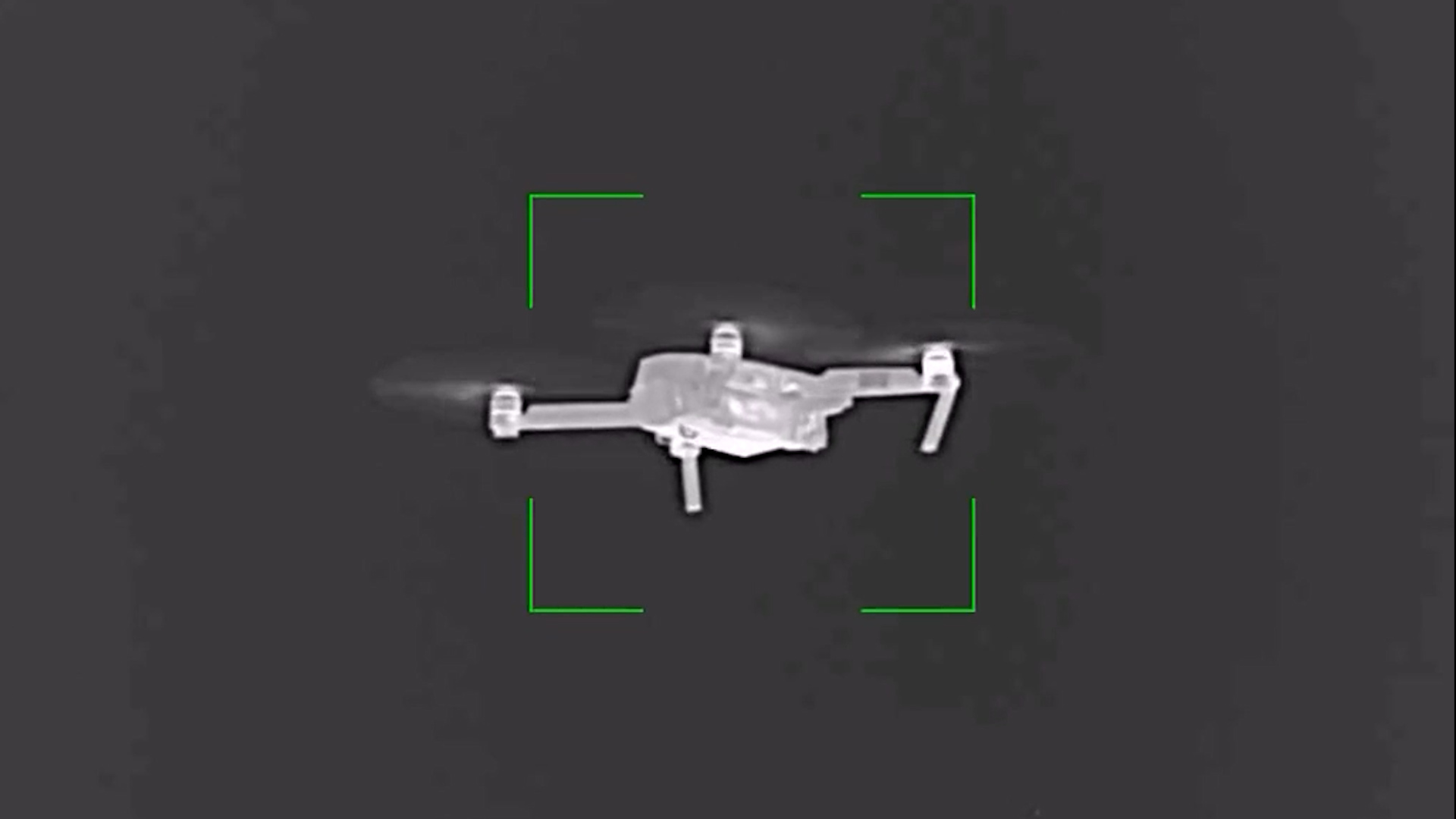
[RYAN ROBERTSON]
WOULD IT SURPRISE YOU TO KNOW DRONES, AT LEAST IN THE MODERN MILITARY SENSE OF THE WORD, HAVE BEEN AROUND FOR MORE THAN A CENTURY?
IN 1907 THREE FRENCH INVENTORS DEVELOPED THE FIRST QUADCOPTER. IT TOOK FOUR MEN TO FLY IT AND IT COULD ONLY GET TWO FEET OFF THE GROUND, BUT IT MARKED THE LAUNCHING POINT FOR THE DRONES WE KNOW TODAY, SOME 117 YEARS LATER.
THE FIRST KNOWN USE OF DRONES IN COMBAT WOULD TAKE PLACE IN 1943 WHEN THE GERMANS DEVELOPED THE F-X-1400, ALSO KNOWN AS THE “FRITZ X”. IT WAS ESSENTIALLY A REMOTE CONTROLLED 2,300 POUND BOMB USED TO SINK SHIPS.
FAST FORWARD TO FEBRUARY OF 2002 WHEN THE CIA USED A PREDATOR DRONE TO TARGET A SUSPECT THOUGHT TO BE OSAMA BIN LADEN.
UNFORTUNATELY, IN THAT INCIDENT, AN INNOCENT MAN OUT COLLECTING SCRAP METAL WAS KILLED.
DESPITE THAT MISTAKE, DRONE USE HAS ONLY GROWN IN SIZE AND SCOPE.
MOST NOTABLY IN UKRAINE’S DEFENSE OF RUSSIA’S ILLEGAL INVASION. FOR MORE THAN TWO YEARS UKRAINIAN TROOPS COUNTERED RUSSIA’S ADVANTAGES IN TROOP NUMBERS AND HARDWARE, BY INNOVATING NEW WAYS TO USE SMALL, COMMERCIALLY AVAILABLE DRONES TO SLOW RUSSIA’S ADVANCE.
THANKS IN PART TO COUNTLESS SOCIAL MEDIA POSTS OF THEIR SUCCESSES, THE WORLD IS WATCHING AND TAKING NOTICE. IT DIDN’T TAKE LONG FOR AMERICAN MILITARY LEADERSHIP TO REALIZE THE NATURE OF COMBAT WAS CHANGING RIGHT THERE ON THE SCREENS OF THEIR SMARTPHONES.
SO THE QUESTION BECOMES, HOW DOES AMERICA, AND ITS ALLIES, BEGIN TO ADAPT?
IT’S A QUESTION THAT IS DOMINATING THE TIME OF THOSE CHARGED WITH FINDING ANSWERS.
FOR MOST AMERICANS, AT LEAST PUBLICLY, THE CLOCK STARTED RUNNING ON JANUARY 28th, WHEN THREE U.S. ARMY SOLDIERS WERE KILLED, AND 47 OTHERS INJURED, IN A DRONE ATTACK ON AN AMERICAN OUTPOST IN JORDAN.
LAUNCHED BY THE IRANIAN-BACKED ISLAMIC RESISTANCE IN IRAQ, IT WAS A WAKEUP CALL FOR MANY. AT THIS YEAR’S AFA WARFARE SYMPOSIUM, RETIRED AIR FORCE COLONEL BRAD REEVES WAS PART OF A ROUNDTABLE ADDRESSING THE MODERN DRONE THREAT.
[Col. Brad Reeves, USAF (Ret.)]
“I want you to grasp this tower. 22 is the first time in over seventy years that US ground forces have been killed by an air attack. I want you to let that sit in for just a minute. This is unacceptable. As airmen we should feel a bit of righteous anger. But also, of course, do something about it.”
[RYAN ROBERTSON]
FOR THOSE INVOLVED IN DEVELOPING SOLUTIONS TO THIS EVOLVING THREAT THERE’S A SENSE OF URGENCY. ESPECIALLY WHEN IT COMES TO ONE OF AMERICA’S OLDEST ADVERSARIES.
[Michael Holl, Requirements and Capabilities Lead, RTX]
“In China, we face a threat where they have the resources and the infrastructure and the pace of patience to develop something way more elaborate than we’ve seen before. As industry, you know, we have to make sure our systems aren’t brittle, that they can stay one step in front of this very sophisticated enemy.”
[RYAN ROBERTSON]
DURING A RECENT VIRTUAL PRESS CONFERENCE HOSTED BY THE CENTER FOR EUROPEAN POLICY ANALYSIS, RETIRED AIR FORCE LIEUTENANT GENERAL LANCE LANDRUM STRESSED STAYING AHEAD OF THE THREAT MEANS TAKING NEW APPROACHES TO GET HARDWARE INTO THE HANDS OF OPERATORS IN THE FIELD.
[Lt. Gen. Lance Lundrum USAF (Ret.)] “I think this is part of us going forward in how we embrace technology, how we embrace a younger generation, who can think about these problems in ways that the older generation just cannot because of our biases, and then the risk, taking the risk environment associated with their acquisition systems to move forward on things that may not be perfect, but get them out there, use them, learn from them and develop them and spiral them differently.”
[RYAN ROBERTSON]
WATCH ENOUGH VIDEO OF UKRAINE’S DRONE EXPLOITS AND IT’S EASY TO GET CAUGHT UP IN THE OFFENSIVE CAPABILITIES DRONES BRING TO THE TABLE. HOWEVER, THE BIGGER PART OF THE EQUATION LIES IN DEFENDING AGAINST THEM. DETECTING AN INBOUND THREAT THAT’S CONSIDERABLY SMALLER THAN A TRADITIONAL MISSILE OR ATTACK AIRCRAFT, STOPPING A SINGLE DRONE, OR A SWARM OF DRONES, WILL TAKE A SIZABLE LEAP IN TECHNOLOGY. A LESSON RUSSIA IS LEARNING THE HARD WAY.
[Lt. Gen. Lance Lundrum USAF (Ret.)]
“I think that we should take that to heart and not have hubris that we wouldn’t have the same problems. There’s one thing about these drones of all different sizes, you know, the small, medium and large, that they can exploit gaps and seams in traditional air defense systems in ways that traditional offensive systems haven’t in the past.”
[Col. Brad Reeves, USAF (Ret.)]
“Passive is certainly I believe the it’s the Holy Grail, it’s where we want to go, as Bart mentioned, the technology is just not mature enough yet to be able to rely on it fully. And also to be able to get most importantly, for it to be a targetable solution. So to be on fire control radar, if you will, of our control solution to get us the accuracy we need for the weapon systems. It’s just not there today, but I do believe it will be soon.”
[RYAN ROBERTSON]
WHILE CHALLENGES PERSIST, PROGRESS IS BEING MADE.
IN MARCH, WE FEATURED THE WORK THE AIR FORCE RESEARCH LABORATORY IS DOING WITH THEIR DRONE INTERCEPTOR, THE PALADIN. A U-A-S ARMED WITH A SHOTGUN THAT FIRES A NET TO INTERCEPT AND BRING DOWN DRONES LOITERING WHERE THEY SHOULDN’T BE.
THERE’S ALSO ENFORCE-AIR BY D-FEND SOLUTIONS, ALLOWING OPERATORS TO NEUTRALIZE ENEMY DRONES BY HACKING-IN AND TAKING TAKING THEM OVER.
AND IN APRIL, THE ARMY CONFIRMED TO MILITARY DOT COM IT DEPLOYED A PAIR OF 20-KILOWATT PALLETIZED HIGH-ENERGY LASERS TO AN UNDISCLOSED OVERSEAS LOCATION. DEVELOPED BY BLUE HALO, THE DEPLOYMENT HIGHLIGHTS THE MILITARY’S INTEREST IN DIRECTED ENERGY WEAPONS TECHNOLOGY.
RTX’S MICHAEL HOLL SAYS FINDING DIVERSIFIED SOLUTIONS, LIKE THOSE, IS THE RIGHT APPROACH.
[Michael Holl, Requirements and Capabilities Lead, RTX]
“So there’s service specific needs, we can’t fall for a one, one size fits all counter drone solution. And we have a sophisticated enemy, we have to have systems that are flexible enough to account for the future threats.”
[RYAN ROBERTSON]
IF YOU’RE INTERESTED IN WATCHING THE TWO EVENTS WE USED IN WRITING THIS STORY JUST LOOK FOR THE LINKS POSTED BELOW.











